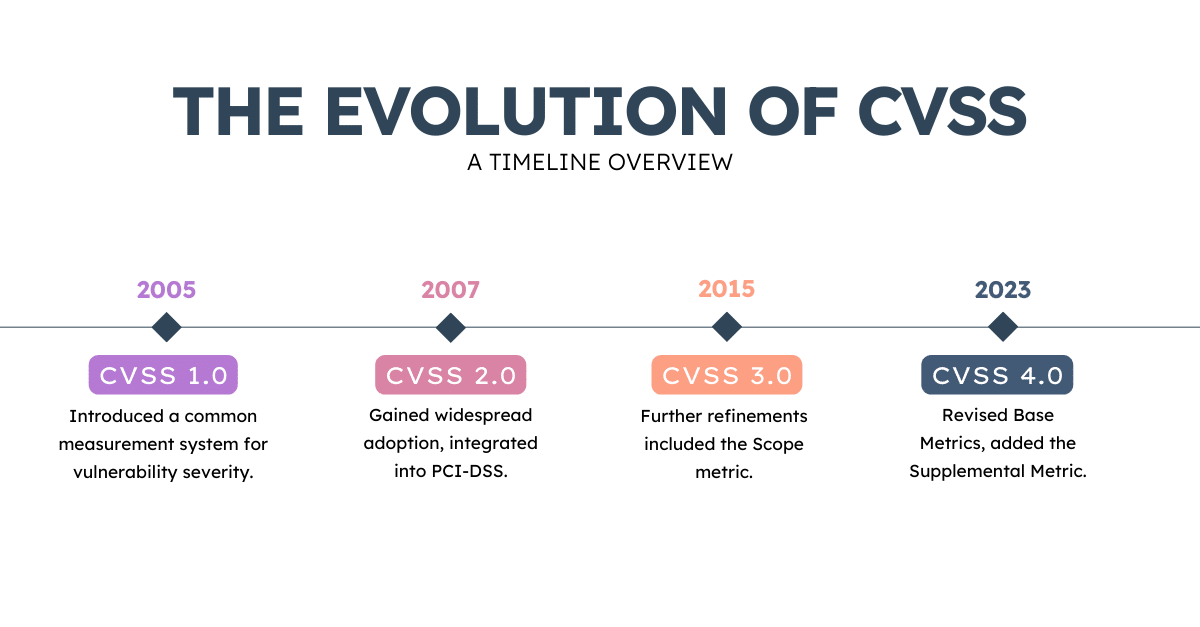Exploring CVSS 4.0: The Next Evolution in Vulnerability Prioritization

Vulnerability prioritization–a critical component of any cybersecurity program–plays an essential role in helping security teams focus on the highest risks to their business. The Common Vulnerability Scoring System (CVSS) has been a widely adopted framework for assessing the severity of vulnerabilities and aiding in the decision-making process. Last week, the Forum of Incident Response and Security Teams (FIRST) officially published the latest version,
CVSS 4.0 introducing new features and improvements to enhance vulnerability assessment and prioritization. In this blog , we’ll review the key aspects of CVSS 4.0, its significance in the industry, and what security and vulnerability management leaders need to know about this upcoming release. Be on the lookout for our future installment, where we’ll take a look at how the Noetic solution is adapting to CVSS 4.0.
Understanding The Common Vulnerability Scoring System (CVSS)
The Common Vulnerability Scoring System (CVSS) is an open framework that enables the communication of vulnerability characteristics and severity. It provides a standardized approach for assessing vulnerabilities, aiding in prioritization and risk management. CVSS was first introduced in 2004 and has since undergone several iterations to refine its capabilities and address the changing threat landscape.
The CVSS Evolution Timeline
CVSS version 1.0, officially released in 2005, aimed to establish a common measurement system for vulnerability severity. It laid the foundation for subsequent versions, which introduced significant enhancements and improvements. Version 2.0, rolled out in 2007, gained widespread adoption and was even integrated into the Payment Card Industry Data Security Standard (PCI DSS). In 2015, CVSS version 3.0 brought about further refinements, including the introduction of the Scope metric to handle vulnerabilities impacting different components.

The Need for CVSS 4.0
As cyber threat landscape has continued to evolve, so has the need for more accurate and comprehensive vulnerability assessment frameworks. CVSS 4.0 addresses this need by introducing several key enhancements and features. The new version aims to provide finer granularity in base metrics, remove scoring ambiguities, simplify threat metrics, and enhance the assessment of environment-specific security requirements.
CVSS 4.0 also recognizes the growing importance of operational technology (OT), industrial control systems (ICS), and the Internet of Things (IoT). It incorporates safety metrics and values to cater to these domains, ensuring a more comprehensive vulnerability assessment.
What’s New in CVSS 4.0?
CVSS 4.0 brings about significant changes and improvements compared to its predecessors. These changes include:
- Revised nomenclature, emphasizing distinct scores such as Base, Base + Threat, and Base + Environmental. This shift aims to underscore the importance of considering multiple factors in vulnerability assessment.
- The introduction of the Supplemental Metric. This optional metric group provides additional contextual information to aid in risk analysis. Metrics like Safety, Automatable, Recovery, Provider Urgency, and Value Density help assess the impact and urgency of vulnerabilities. Provider Urgency, for example, is a way that software vendors can make it clear that this vulnerability needs to be patched immediately.
- CVSS 4.0 also introduces a new Attack Requirement metric, which provides more granularity in capturing the prerequisite conditions enabling an attack.
- The Threat Metrics, previously known as Temporal Metrics, have been simplified and renamed to emphasize real-time vulnerability assessment.
Benefits and Challenges of CVSS 4.0
CVSS 4.0 offers several benefits that enhance vulnerability prioritization and risk management. The introduction of finer-grained metrics allows for a more precise assessment of vulnerabilities, enabling organizations to prioritize their remediation efforts effectively. The inclusion of safety metrics and values for OT, ICS, and IoT domains further expands the applicability of CVSS for many organizations and supports a consistent cybersecurity methodology across the IT and OT environments.
However, many of these new CVSS 4.0 capabilities will be challenging for organizations to take advantage of. Security teams need to ensure that they have a comprehensive updated asset inventory, and the ability to map internal assets to relevant threat intelligence. Without these contextual insights, the true impact of vulnerabilities may not be accurately reflected, limiting the effectiveness of vulnerability management processes.
The increased complexity of CVSS 4.0 and the reliance on end-user input for certain metrics may lead to inconsistencies in scoring, as noted in this recent article. Security leaders will have to think about the resources and staffing they need to provide the necessary data for these metrics to ensure accurate vulnerability assessment, all against the ever-growing number of new vulnerabilities to address.

Source: NIST National Vulnerability Database Dashboard as of November 7, 2023.
A Milestone in Vulnerability Prioritization
Vulnerability prioritization is a critical aspect of cybersecurity, ensuring that organizations allocate resources effectively to address the most severe vulnerabilities. CVSS 4.0 represents a significant milestone in the evolution of vulnerability assessment frameworks, introducing finer granularity, improved metrics, and expanded applicability to OT, ICS, and IoT domains.
For organizations to take advantage of these new metrics and granularity, they need to have a greater understanding of both their internal environment and relevant threat and exploitability insights. Their ability to build and maintain an accurate and continuously updated asset inventory is a critical component to effective vulnerability prioritization using the CVSS 4.0 model, and that is where Cyber Asset Attack Surface Management (CAASM) solution like Noetic can add significant value.
